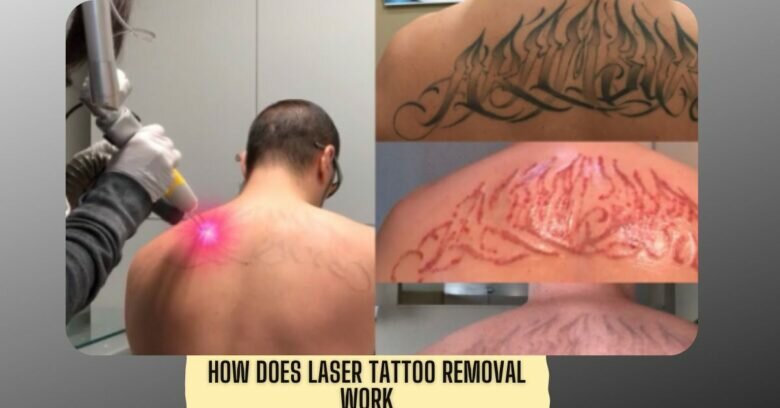Laser tattoo removal is a procedure that uses a specialized laser to break down the ink particles in a tattoo. The laser produces short bursts of intense light that the ink particles absorb, causing them to break down into smaller pieces. The body’s immune system can then metabolize and eliminate these smaller pieces.
The procedure is usually performed by a dermatologist or a specialist in laser surgery. Before the process, the area to be treated before the process is typically numbed with a local anesthetic to minimize discomfort. The laser is then directed at the tattoo, and the energy from the laser is absorbed by the ink particles, breaking them down into smaller pieces.
Laser tattoo removal can be long and expensive, as it typically requires multiple treatments to remove a tattoo entirely. The number of treatments needed depends on the size, location, and color of the tattoo and the type of ink used. Black ink is generally the easiest to remove, while colors like green and yellow are more complex.
Tattoo removal is not always successful in completely removing a tattoo. It can sometimes result in scarring or changes in the skin’s pigment. It is also possible for the tattoo to reappear after treatment, although this is rare.
Read more: How Tattoo Ink Is Made-2023 Guide
disadvantages of laser tattoo removal
There are several potential disadvantages to laser tattoo removal, including:
- Cost: Laser tattoo removal can be expensive, especially if multiple treatments are needed.
- Time commitment: The laser tattoo removal process can take several months, and multiple treatments are usually required.
- Pain: While most people do not find the procedure overly painful, some may experience discomfort during and after treatment.
- Risk of scarring: There is a risk of scarring after laser tattoo removal, exceptionally if the skin is not cared for properly after the procedure.
- Risk of skin color changes: Laser tattoo removal can sometimes result in changes in the color of the treated skin, although this is rare.
- Incomplete removal: Laser tattoo removal is not always successful in completely removing a tattoo and may leave behind faded or partially visible ink.
- Risk of infection: As with any medical procedure, there is a risk of disease with laser tattoo removal.
- Risk of an allergic reaction: Some people may be allergic to the laser or the anesthetic used during the procedure.

It is essential to carefully weigh the potential risks and benefits of laser tattoo removal before deciding to undergo the procedure.
Tattoo removal side effects cancer
There is no direct link between tattoo removal and cancer. Laser tattoo removal is a relatively safe procedure by a trained and experienced professional. However, as with any medical procedure, there is always a risk of potential side effects.
Laser tattoo removal may cause the following side effects:
- Pain: The procedure can be painful, although most people do not find it overly bitter. The tattoo will be numbed before the process, but discomfort may be experienced during and after the treatment.
- Swelling: It is typical for the treated area to be swollen for a few days after the procedure.
- Redness: The treated area may be red and irritated for a few days after the procedure.
- Blistering: Blistering may occur in some cases, although this is rare.
- Infection: There is a risk of disease with any medical procedure, although this risk is low with laser tattoo removal.
- Scarring: There is a risk of scarring after laser tattoo removal, although this is more likely to occur if the skin is not adequately cared for after the procedure.
It is essential to carefully follow the aftercare instructions provided by the practitioner to minimize the risk of side effects and ensure the best possible results. You must contact the practitioner or a healthcare provider for further evaluation if you experience any unusual symptoms or side effects after a laser tattoo removal procedure.
treatment for tattoo removal
Tattoo removal can be accomplished in several ways, including:
- Laser tattoo removal: This method is the most commonly used to remove tattoos. It involves using a specialized laser to break down the ink particles in the tattoo, which can then be metabolized and eliminated by the body’s immune system. Laser tattoo removal can be expensive and time-consuming, and it may require multiple treatments to remove a tattoo entirely.
- Surgical removal: Surgical removal involves physically cutting out the tattooed skin and closing the wound with sutures. This method is typically reserved for small tattoos or tattoos that have failed to respond to other removal methodsDermabrasion: Dermabrasion involves using a rotating tool to sand down the top layers of skin, removing the tattooed area. It may result in scarring and is painful.
- Chemical peels: Chemical peels involve using a chemical solution to remove the top layers of skin, which may include the tattooed area. Scarring may occur as a result of this method.
- Creams and ointments: Various creams and lotions claim to remove tattoos, but their effectiveness is questionable. Some of these products may contain harmful ingredients and can cause skin irritation.
conclusion
In conclusion, laser tattoo removal is a popular method of removing tattoos that uses a specialized laser to break down the ink particles in the tattoo. The procedure is usually performed by a dermatologist or a specialist in laser surgery, and it can be expensive and time-consuming and may require multiple treatments.
There is a risk of side effects with laser tattoo removal, including pain, swelling, redness, blistering, infection, and scarring. There are also several other options for tattoo removal, including surgical removal, dermabrasion, chemical peels, and creams and ointments, but their effectiveness and safety can vary.

